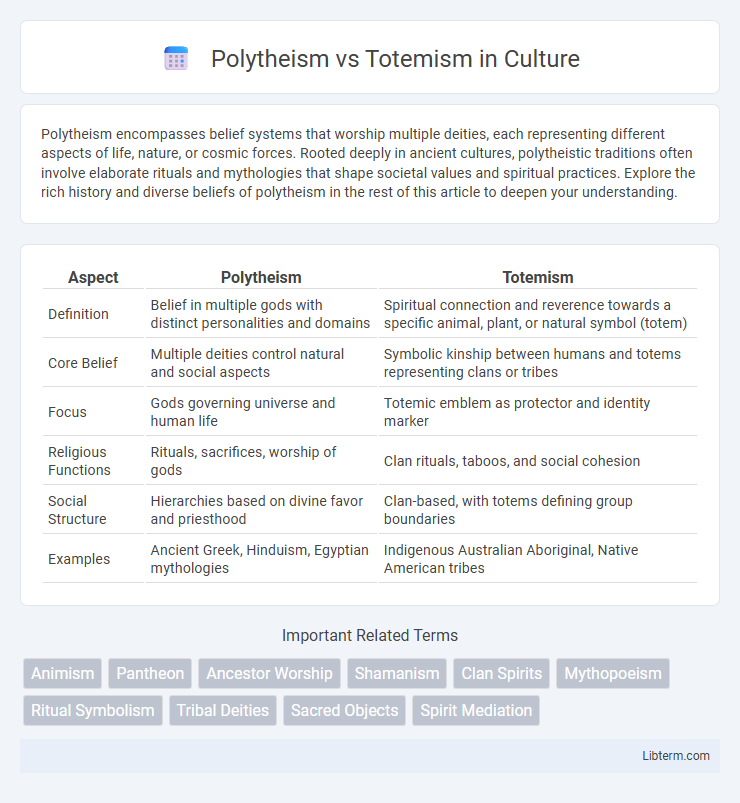Polytheism encompasses belief systems that worship multiple deities, each representing different aspects of life, nature, or cosmic forces. Rooted deeply in ancient cultures, polytheistic traditions often involve elaborate rituals and mythologies that shape societal values and spiritual practices. Explore the rich history and diverse beliefs of polytheism in the rest of this article to deepen your understanding.
Table of Comparison
| Aspect | Polytheism | Totemism |
|---|---|---|
| Definition | Belief in multiple gods with distinct personalities and domains | Spiritual connection and reverence towards a specific animal, plant, or natural symbol (totem) |
| Core Belief | Multiple deities control natural and social aspects | Symbolic kinship between humans and totems representing clans or tribes |
| Focus | Gods governing universe and human life | Totemic emblem as protector and identity marker |
| Religious Functions | Rituals, sacrifices, worship of gods | Clan rituals, taboos, and social cohesion |
| Social Structure | Hierarchies based on divine favor and priesthood | Clan-based, with totems defining group boundaries |
| Examples | Ancient Greek, Hinduism, Egyptian mythologies | Indigenous Australian Aboriginal, Native American tribes |
Introduction to Polytheism and Totemism
Polytheism is a religious belief system characterized by the worship of multiple deities, each often associated with specific aspects of life, nature, or human experience. Totemism revolves around the spiritual connection between a group or individual and a totem, which is usually an animal, plant, or natural object symbolizing the group's ancestry, identity, or protective spirit. Both systems serve to explain the world and foster social cohesion, but polytheism emphasizes divine multiplicity, while totemism centers on symbolic kinship and ancestral ties.
Defining Polytheism: Belief in Multiple Deities
Polytheism is characterized by the belief in multiple deities, each with distinct identities, powers, and domains such as nature, war, or fertility. This religious system often involves worshiping gods and goddesses who represent various aspects of life and the cosmos, reflecting a complex pantheon. Unlike totemism, which centers on symbolic associations with natural objects or animals, polytheism emphasizes individualized divine beings with mythologies and rituals dedicated to them.
Understanding Totemism: Spiritual Connection to Nature
Totemism represents a spiritual connection to nature where clans or groups identify with a particular animal, plant, or natural object as their emblem and guardian spirit, symbolizing ancestral lineage and collective identity. Unlike polytheism, which worships multiple deities with distinct personalities and domains, totemism centers on the sacred relationship between humans and their totems, emphasizing harmony, respect, and interdependence with the natural world. This belief system reinforces social cohesion and ecological awareness through rituals and myths that highlight the spiritual significance of the natural environment.
Historical Origins and Development
Polytheism originated in ancient civilizations such as Mesopotamia and Egypt, characterized by the worship of multiple gods representing natural forces and human experiences. Totemism developed primarily among indigenous communities, linking clans or tribes to specific animals or plants as spiritual ancestors and symbols of identity. Both belief systems played foundational roles in shaping social structures and religious practices throughout history.
Core Beliefs and Practices
Polytheism centers on the worship of multiple gods, each associated with distinct aspects of life and nature, emphasizing rituals and offerings to honor these deities. Totemism involves a spiritual connection between humans and a particular animal, plant, or natural object, regarded as a sacred ancestor or emblem, guiding social identity and clan relationships. Core practices in polytheism include temple worship and festivals, while totemism focuses on symbolic veneration and taboos linked to the totem entity.
Polytheism Across Cultures
Polytheism manifests uniquely across cultures, such as the Hindu pantheon with thousands of deities representing various aspects of life and nature, and the ancient Greek gods embodying human traits and natural forces. In polytheistic systems, gods often have specialized domains, rituals, and mythologies that shape social norms and religious practices. This diversity contrasts with totemism, where symbolic animal or natural emblems unify clans, emphasizing kinship and ancestral lineage rather than a pantheon of distinct deities.
Totemism in Indigenous Societies
Totemism in Indigenous societies serves as a social and spiritual system where clans or groups identify with a specific animal, plant, or natural object, believed to share a kinship or ancestral connection. This belief fosters a profound respect for nature and reinforces community bonds through rituals, taboos, and storytelling centered on the totem. Unlike polytheism's worship of multiple gods, totemism emphasizes symbolic relationships that guide moral conduct and cultural identity within Indigenous communities.
Symbolism and Rituals in Both Systems
Polytheism employs a complex pantheon of gods with distinct domains, each symbolized by unique attributes, animals, or elements, and rituals often involve elaborate ceremonies, sacrifices, and temple worship to honor these deities. Totemism centers on clan or tribal totems--animals, plants, or natural objects--that symbolize group identity and spiritual ancestry, with rituals focusing on totemic veneration, protection, and ancestral connections through storytelling, dances, and taboos. Both systems use symbolism and ritual as means to connect the human community with the spiritual world, reinforcing social cohesion and cultural values.
Influence on Social Structure and Identity
Polytheism often reinforces hierarchical social structures by associating different gods with distinct social roles, statuses, and governance systems, thereby shaping collective identity around divine authority and organized worship. Totemism strengthens clan-based identities through symbolic associations between groups and specific animals or natural elements, promoting social cohesion and kinship bonds within communities. The influence of polytheism tends to emphasize centralized religious institutions, while totemism fosters egalitarian social relations centered on shared lineage and ecological connections.
Comparative Analysis: Similarities and Differences
Polytheism and totemism both involve belief systems centered around multiple entities, with polytheism worshiping a pantheon of gods and totemism attributing spiritual significance to natural symbols or animal clans. Polytheism typically incorporates complex rituals and mythologies linked to deities with distinct personalities and powers, whereas totemism emphasizes kinship ties and communal identity through symbolic animals or plants. Both systems provide frameworks for understanding the natural world and social organization but differ fundamentally in their conceptualization of divinity and spiritual representation.
Polytheism Infographic

 libterm.com
libterm.com